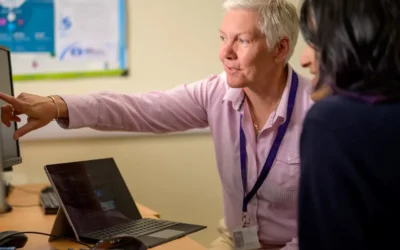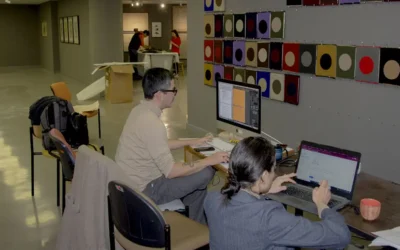Museum TrendsWatch: Livable Communities for Our Elders

Rachael Cristine Woody
This week continues our review of Center for the Future of Museums’ TrendsWatch report. This year the unifying theme is Museums as Community Infrastructure, with the identification of five pillars.
The Center for the Future of Museums (CFM) is under the auspices of American Alliance of Museums and offers a trends forecast that typically covers five topics, sometimes all related, sometimes not. This week’s pillar is Communities for Our Elders. To begin, CFM Founding Director Elizabeth Merritt summarizes a few of society’s broader physical infrastructure issues that can keep seniors from participating in the world as fully as they would like. Those items are: multi-story buildings, steps to get in and out of places, lack of safe transportation, and limited opportunities for social outlet. According to Merritt, “Many aspects of traditional museum design are age-hostile, including the lack of seating, sensory overload, and barriers to physical accessibility.”
This Includes the Digital Spaces
This section continues with Merritt drawing a parallel to the digital world being built in a similar exclusionary manner to an aging population. Merritt ends the introduction with a study from the pre-COVID era where 40% of people over the age of 65 have some kind of mental or physical disability. (I wrote about this topic in early spring 2020 via Lucidea’s Think Clearly Blog: Removing Museum Barriers to Entry for Aging Adults). First and foremost, this an accessibility issue and should be addressed as part of a larger Diversity, Equity, Accessibility, and Inclusion (DEAI) issue. For museums, this will require a focus on both the physical and digital visitor experiences and how we can adapt those environments to be more inclusive and more accessible to everyone—including our elders.
Volunteering Remains, For Better or Worse
Many who work in nonprofits understand that the call to serve can be incredibly gratifying for volunteers. However, there are additional benefits that can be gained. As Merritt explains,
[…] the opportunity to volunteer is one of the major benefits nonprofits provide to society. Copious research documents that volunteering helps individuals expand their connections, feel good about themselves, improve their physical well-being, combat social isolation, reduce stress, and learn new skills—benefits that are particularly helpful in supporting healthy aging.
However, the opportunity isn’t without its issues. Volunteer models operate on a similar inequitable premise as unpaid internships. In order to seize the opportunity (and reap the benefits) of volunteering, one must be at a certain level of economic privilege and able bodyness. As Merritt accurately states: “Volunteerism can exacerbate inequality if, as in many museums, it is only accessible to people who are already comparatively privileged.” This problematic premise—that it’s socially acceptable to not compensate people for their labor—is difficult to reconcile with the asserted point earlier in this section that society should be more aware of the wisdom and expertise seniors have to share. What requires further exploration (and not addressed in TrendsWatch) is how to evolve our thinking that these exchanges are always the dynamic of unpaid volunteer (senior) to paid staff (younger person). This is a gap too large to be left unaddressed by CFM and I hope we see it in future works.
Assumptions Museums Continue to Make
Additionally, museums may be continuing to underserve the senior population because they continue to assume (incorrectly) that persons over the age of 50 are one of their biggest demographics served and, therefore, no changes are needed to attract or better serve this population. This couldn’t be farther from the truth, as I wrote in April 2020 via Lucidea’s Think Clearly Blog: The Numbers on the Millennial Museum Visitor.
What Museums Can Do
The core actions from this section are:
- Consider the museum a place that fosters social connection
- Offer employment opportunities (not just volunteer opportunities) to seniors
- Provide mental and physical engagement opportunities that seniors can fully participate in both in the physical space as well as the digital
- Use the museum’s influence and platform to combat ageist stereotypes
A Framework for Action
Each TrendsWatch section includes an “Action” area. The following is a summary of those actions for this section:
- Inventory and work toward eliminating age-based barriers to access in the following areas: comfort, cultural, social, and transportation.
- Create training to help eliminate ageist behaviors, beliefs, and decisions.
- As a part of inclusion analysis, make sure seniors are represented in museum programs, exhibit content, and marketing.
- Provide a platform for seniors to share their culture, wisdom, expertise.
- Help establish connections and facilitate dialogue in the museum and community-at-large to help eliminate ageism and foster intergenerational connections.
Conclusion
For more information on what peer museums have done in this area, and for more in-depth analysis on this topic, please view the original report available via the CFM TrendsWatch website. Next week we move on to the second pillar of community infrastructure: Mental Health for All.

Rachael Cristine Woody
Rachael Cristine Woody advises on museum strategies, digital museums, collections management, and grant writing for a wide variety of clients. In addition to several titles published by Lucidea Press, she is a regular contributor to the Think Clearly blog and an always popular presenter. And remember to check out Lucidea’s Argus solution for powerful and innovative museum collections management.
Never miss another post. Subscribe today!
Similar Posts
How to Incorporate Interns in Museum CMS Projects: Data Cleanup and Refinement
A museum expert details how interns can be successfully included in museum CMS projects at the data cleanup and refinement stage.
How to Incorporate Interns in Museum CMS Projects: Data Creation
A museum expert details how interns can be successfully included in museum CMS projects at the data creation stage.
How to Incorporate Interns in Museum CMS Projects: Data Capture
A museum expert highlights how interns can be included in museum CMS projects at the data capture stage
How to Incorporate Interns in Museum CMS Projects
A museum expert highlights how interns can be included in museum CMS projects with three project ideas.
Hosting service
Enjoy all of the benefits of your Lucidea solution with secure, reliable, stress free hosting
Programs & incentives
No matter your size or budget, we’ve got you covered, today and tomorrow




Leave a Comment
Comments are reviewed and must adhere to our comments policy.
0 Comments